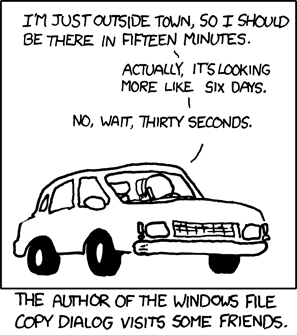
Friday Funnies: Estimated time


With the pending LPFM filing window in October, I decided that perhaps I could spread the information to some local groups that might want to put a community radio station on the air where I live. Back over a decade ago, there were a couple of local commercial AM and FM stations in the area, but they moved out of town to a larger city some 24 miles to the east. If local legend is to be believed, the AM station was very popular, with its studios and offices over the local pharmacy. That station is now running 24/7 comedy, which given the area, is ironic almost beyond words. As it stands now, this is one of those rural areas that, on paper, looks well served by several different radio stations. Truth is, there are radio signals receivable here, but there is no local radio. The last time anyone from those previously local stations had a meaningful thought about the respective Cities of License was months if not years ago.
With all this in mind, I first approached a local community non-profit group. They seemed mildly interested but expressed doubt about finding a studio location. Their basic take was, we can help, but we want others involved. Seemed to be a lukewarm, but understandable and not totally unwarranted response.
I then approached the local school board. The idea was to get the high school involved with the station broadcasting sports events and teaching kids how to do play-by-play and perhaps other types of radio shows. They fainted interest at first, then decided that they didn’t have the staff to deal with a broadcast program and there were other excuses like “liability issues.”
I then approached the local governments (two different towns) who were almost openly hostile to the idea. While they didn’t say as much to my face, they rather implied that it would be a waste of time and that the town(s) were not interested.
I have approached other local groups, which don’t seem to be interested at all.
Has radio lost its mojo with the local population? Are we who still remain in the radio business simply fooling ourselves into thinking that somehow this is important? I don’t know.
The hazards of rural LPFM; are large areas, few people, and generalized indifference.
When I said the WBCN test data may not see the light of day, perhaps I spoke too soon. For your viewing pleasure, here are the results of the WBCN all-digital HD Radio tests:
WBCN All-digital AM IBOC Field Test Project (link has been broken, this may have been released by accident)
Well, that will teach me, won’t it.
I have given it a summary read and my first impressions were correct; from a technical standpoint (antenna, ATU) this is a very favorable test configuration. The results look pretty good on the surface, although they appear to have had some nighttime interference problems, go figure. I’ll update this post when I have time to fully read the whole paper.
Update: The link I provided earlier has been taken down. It may be that the information was not supposed to be released to the general public. Several people have asked me to upload the report to my own server so that they can download it and read it themselves. This leaves me in a bit of a quandary; the report itself is important information and its implications for the future of broadcasting are huge. On the other hand, it is the work of a private organization and not the public domain, thus if released by accident, then it should not be shared.
This story from Inside Radio is more or less accurate as to what the report contains, although it paints a somewhat favorable picture. There appear to be some issues meeting the NRSC5C mask for the MA3 (all digital) mode. That seems to be fine, however, as the NRSC5C mask can be modified to meet field conditions. How convenient is that? The information about the number of AM HD Radio stations seems a bit off, latest I have is 207 AM daytime, and 66 AM nighttime stations out of 4,659 transmitting hybrid digital-analog HD Radio, or 4% daytime and 1% nighttime respectively.
When I have time, I will do some more analysis and post my own conclusions.
Congress, is yet again contemplating a cyber security bill, this time called CISPA. This one has some worrisome privacy implications for the general internet user. I recall, not too long ago, another such measure called SOPA/PIPA which created a huge uproar and was voted down. For Congress and its corporate sponsors, this development was just a slight inconvenience when applying the “if at first, you don’t succeed, try, try again,” legislative method.
Not mentioned in this particular bill is the internet kill switch, which exists now in one form or another, and the unofficial back doors into operating systems and routers. Those things are in place but their use is not codified. The internet can be monitored, user data can be stored indefinitely and it can be restricted or switched off at a moment’s notice. That is the reality of the world we live in.
This is why a vibrant, independent radio broadcasting medium is important. After doing some numbers crunching over the weekend, I came upon some pretty interesting data points:
Therefore, approximately 3,200 of the 15,803 stations on the air are controlled by major corporate interests or media conglomerates, the remaining stations are owned by medium-small groups (less than 30 stations) or individuals. Those figures create an interesting situation when discussing the future of radio. What do the majority of owners and listeners want? Ask the market.